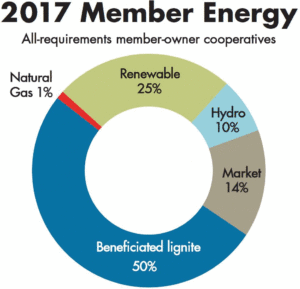The Western Area Power Administration (WAPA) manages federal hydro dams which provide McLeod Co-op Power with about 7% of its electrical energy needs. The other 93% of the Co-op’s power is from its wholesale power provider Great River Energy (GRE). GRE is a regional generation and transmission cooperative, owned by McLeod and 27 other rural electric cooperatives.
 Of the energy purchased from GRE 25% is from renewable sources today, with a goal of being 50% renewable by 2030.
Of the energy purchased from GRE 25% is from renewable sources today, with a goal of being 50% renewable by 2030.
GRE has a goal to supply its member-owner cooperatives with energy that is 50 percent from renewable resources by 2030. This voluntary goal will more than double the current renewable energy supply delivered to you.
Great River Energy has already met Minnesota’s 25 percent renewable energy standard eight years ahead of requirements. We continue to evolve our power supply portfolio, delivering even more renewable energy to our member-owner cooperatives to help them remain competitive in a changing market.
It is adding this renewable energy to the power supply portfolio for its all-requirements member-owner cooperatives, like McLeod Co-op Power.
Great River Energy has spent more than a decade positioning its portfolio, lowering costs and reducing dependence on coal as a fuel source, while improving the overall flexibility of its generation portfolio. These measures have resulted in a 35 percent reduction in their carbon dioxide emissions since 2005.
Great River Energy has exited two contracts for coal-based electricity in recent years and, in 2017, retired a North Dakota power plant owned by the cooperative. Improvements at Great River Energy’s Coal Creek Station power plant have reduced the plant’s emissions of sulfur dioxide and mercury by up to 40 percent, nitrogen oxides by 20 percent and carbon dioxide by 4 percent in recent years, while operational adjustments allow the plant to ramp down production when market conditions warrant.
Great River Energy’s renewable portfolio currently includes 468 megawatts (MW) of wind energy, 200 MW of hydropower, 4 MW of solar and 30 MW of biomass. Great River Energy has announced plans for an additional 300 MW of favorably priced wind energy by 2020. Renewable energy, particularly wind, is currently GRE’s lowest-cost option for new generation resources.
